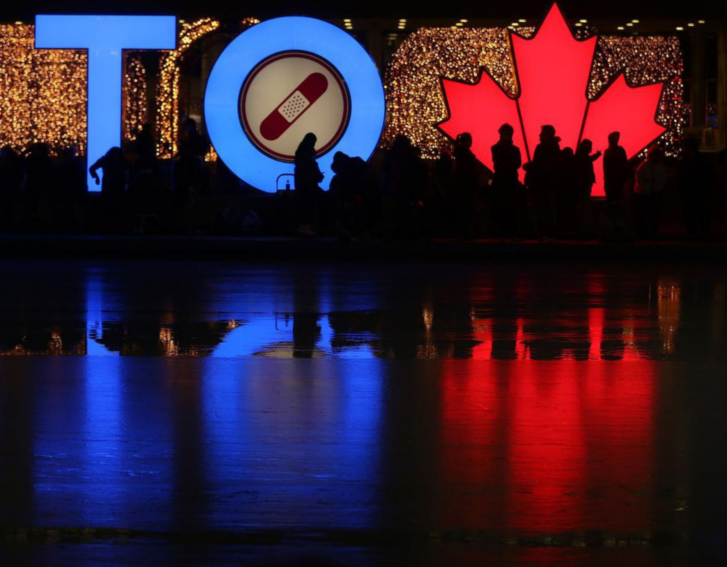As the Omicron variant takes hold in Toronto, the very shape of infections in the city has shifted — with the hotspot for positive cases now concentrating in the dense downtown core.
While in earlier waves, the virus scorched through Toronto’s northwest corner — and just weeks ago, hot spots started popping up in new areas such as Old East York and Mimico — now, the worst-hit part of the city has become the waterfront neighbourhood, with an infection rate of 625 cases per 100,000 people over the last three weeks, excluding cases in retirement homes and long-term care.
Other nearby areas such as Trinity-Bellwoods and Niagara have seen similarly high rates.
The precise reason for the downtown concentration is unclear, with epidemiologists suggesting theories from unequal testing access to the impacts of postinfection immunity; while Toronto Public Health and Toronto’s board of health chair Joe Cressy point to social gatherings as a likely driver behind the surge.

“The same trend that we saw at the beginning of the second wave is what we’re seeing right now. Transmission is largely being fuelled through gatherings, as opposed to during lockdown periods, when it was largely through work,” Cressy said.
“The downtown communities are the youngest neighbourhoods in the city, and we have a lot of young people who are gathering.”
While Toronto Public Health says exact reasons for neighbourhood rate fluctuations may not always be discernible — listing influencing factors such as school outbreaks — in an email to the Star,it said it saw get-togethers during the holiday season as one factor in rising cases, and also noted a shift from workplace transmission to contact in more “private and social gatherings.”

The agency didn’t specify any age cohort, while also suggesting other “possible explanations” such as neighbourhoods having a higher concentration of children who were only recently eligible for vaccinations, or the increased transmissibility of the new Omicron variant.
Isaac Bogoch, an expert of infectious diseases with the University of Toronto, said he couldn’t say for certain why cases were concentrating downtown in the last three weeks.
“There are obviously theories here,” he said, while cautioning that any suggestions came with an “enormous grain of salt.” One of those theories, he said, was that with demand rising, access to the PCR testing needed to officially record a positive case could be uneven throughout the city.
He and fellow epidemiologist Susan Bondy also suggested there may be higher rates of immunity in previously ravaged communities, from those who contracted and recovered from COVID-19 as well as vaccine efforts that targeted hard-hit neighbourhoods.
Throughout the fourth wave, city data shows the percentage of cases coming from 18- to 29-year-olds overall — 23.8 per cent, as of Tuesday — has been similar to the second and third wave, and higher than the first wave.
That age cohort has seen the steepest increase in its rate lately, going from 17.8 per cent the week of Nov. 28, to 21.8 per cent the week of Dec. 5.
But Andrew Boozary, executive director of social medicine at the University Health Network, cautions against “shaming and blaming” certain populations when their case counts rise.
“I don’t think we can have the knee-jerk reflex to say, ‘this is about young people who are going out in the downtown core.’ There may be elements of that. But we’re allowing nightclubs to be open,” he said, suggesting that younger people may also work in front-line jobs or live in more tightly packed homes. (A few days ago, the province introduced new restrictions that require bars and restaurants to close their doors at 11 p.m. and reduced their capacity limits.)
Across Ontario, the latest data shows a record number of outbreaks in recreational facilities such as bars, nightclubs, venues and gyms. In Toronto, patrons who visited establishments such as the Cineplex at Yonge-Dundas Square, Bar Raval and Lopan Bar on College Street, and History concert venue on Queen Street East during specific hours have been asked to monitor themselves for symptoms.
As cases have picked up again, some downtown establishments have made the decision to close their doors temporarily through the holidays. The restaurant Calii Love has recently paused operations at two of its stores in Toronto due to positive cases among staff.
When looking at spread, Boozary — like Bogoch — questioned the role of test access. If someone was unable to get tested, or could only access a rapid test that went unrecorded in the larger case counts, he said it was harder to paint a full picture of where the virus was spreading.
Still, for some young people downtown, the surge in cases has been palpable.
Kyle Noble, 28, says it now feels like playing “Russian roulette” to avoid an infection, as more and more people he knows downtown have tested positive.
He was recently notified about a potential exposure at his gym. When his throat began to scratch, he immediately sought a test.
After spending hours scouring pharmacies and testing centres, Noble found an appointment on the other side of the city, which is scheduled to take place on Wednesday. The experience made him wonder how many cases in the downtown core may still be going undetected.
“It makes me lose a lot of faith in how far we’ve come,” he said.
Article From: The Star
Author: Victoria Gibson, Irelyne Lavery

